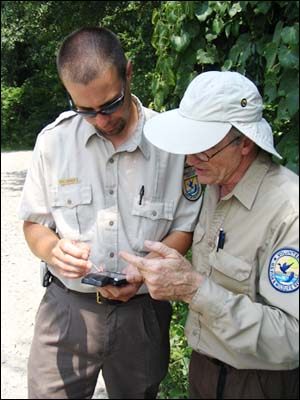National Wildlife Refuge System
 |
| Mapping Invasive Plants at Cache River NWR |
| Credit: USFWS |
The Fish and Wildlife Service manages 548 refuges, encompassing 96 million acres of wildlife habitat, within its National Wildlife Refuge System (NWRS). According to Fiscal Year 2007 data, 2.4 million acres of the NWRS are impacted by invasive plants. In addition there are approximately 4,400 invasive animal populations residing on refuge lands. Invasive species are the most frequently mentioned threat in the NWRS Threats and Conflicts database. Instead of focusing on native habitat protection or enhancement, refuge management operations are becoming more frequently tied to battling invasive species. Federally listed threatened and endangered species are also experiencing more direct impacts from exotic invasions.
In conjunction with its National Strategy for Management of Invasive Species (324 KB PDF), the NWRS is taking a variety of innovative and aggressive steps to deal with its burgeoning invasive species issues.
- Download program update for Fiscal Year 2008 (214 KB PDF)
- Download program update for Fiscal Year 2007 (234 KB PDF)
- Download program update for Fiscal Years 2005 and 2006 (1 MB PDF)
- The NWRS is leading Department of the Interior natural resource agencies in using volunteer labor to manage, map and monitor invasive plant infestations on refuges across the country. Between 2004 and 2007, approximately 2,750 volunteers engaged in the volunteers and invasives program have spent over 49,000 hours working with refuge staff to manage and control invasive species on more than 211,000 acres of refuge land. An additional 200 volunteers have been trained to use hand held computers and GPS devices to map invasive plants. Partners working with us on this program include the National Wildlife Refuge Association (NWRA), The Nature Conservancy (TNC), and USGS's National Institute for Invasive Species Science. Reports and maps produced by refuges participating in the volunteers and invasives program are available on the NWRA volunteers and invasives Web page.
- We invite you to use our award-winning online training program for volunteers," Volunteers and Invasive Plants: Learning and Lending a Hand". This program was developed in collaboration with the Center for Invasive Plant Managment and designed to engage refuge volunteers and the general public in invasive plant issues and management through provision of science-based, introductory information. The five self-study modules address topics ranging from how volunteers can help refuges manage invasive plants, to the invasion process, to tips for community presenters. Each module contains a quiz and web-based resources that enable learners to explore topics more thoroughly.
- We have also developed an online training program for Refuge Staff, "Managing Invasive Plants: Concepts, Principles, and Practices." This program was developed especially for staff of the National Wildlife Refuge System in collaboration with the Center for Invasive Plant Management and can be used as an introduction to the fundamentals of invasive plant management or as a refresher for staff already engaged in management activities. It focuses on planning and assessing, as well as specific IPM strategies, such as biocontrol, chemical, mechanical, and prescribed grazing and burning. This course is recommended as a supplement to the hands-on course, "Field Techniques for Invasive Plant Management" held annually at the National Conservation Training Center in Shepherdstown, West Virginia.
- Five Invasive Species Strike Teams are working to protect refuges in key geographic locations, such as the Florida Everglades, the lower Colorado river basin, the Columbia-Yellowstone-Missouri river watershed, the Prairie Pothole region of North Dakota, and the Hawaiian and Pacific Islands. The purpose of these teams is to respond rapidly to new infestations and offer technical expertise to refuges that may not have available staff and funding to treat infestations. The NWRS hopes to implement more teams in the future.
- Fire and invasive plants are often intimately linked. Fire management activities can create ideal opportunities for invasions by nonnative plants, potentially undermining the benefits of fire managment actions. With this in mind, we have developed a handbook, Fire Management and Invasive Plants: A Handbook, to help both fire and invasive plant managers determine the best approach. (1.3 MB PDF)
- Finally, the NWRS is encouraging refuges all across the nation, whether they currently have major invasive species issues or not, to take invasives into account in all their planning through the Comprehensive Conservation Plan process and through implementing Hazard Analysis and Critical Control Point planning in their day-to-day operations.